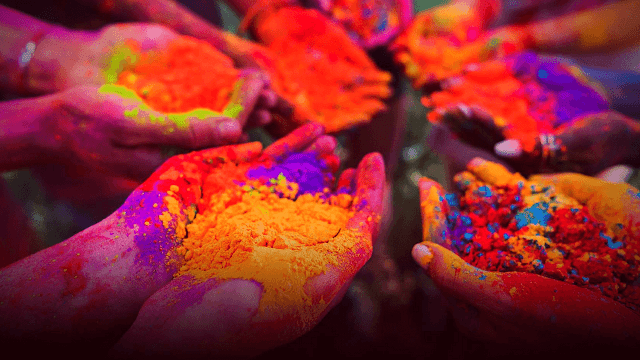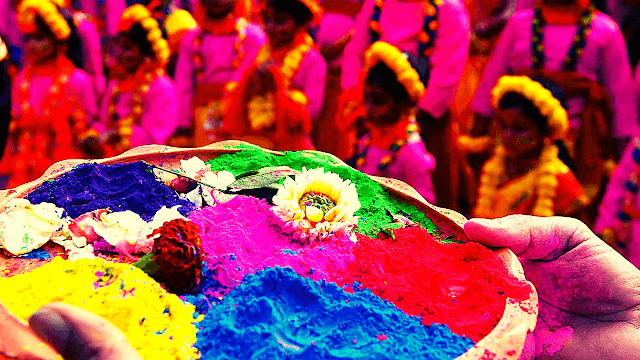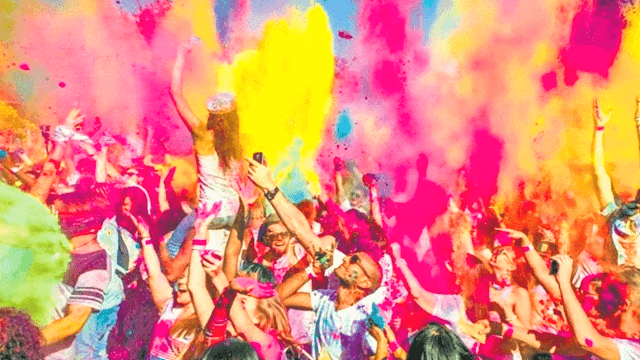Festival of Holi
country. Every festival is celebrated with diverse rituals and methods. There are festivals celebrated
only in some parts of the country like Onam, Pongol, Jallikattu, etc. While on the other hand there are
festivals celebrated throughout the country in a unified manner. Holi is an example of such a festival
where the whole nation celebrates the festival of colours with huge grandeur and in a unified
manner.
There are many stories and beliefs explaining the reason why we celebrate the festival of Holi. The
most prominent one is the story of Prahlad. Prahlad was the son of the demon King Hiranyakashyap.
King Hiranyakashyap had a boon that he could not be killed in any manner. Not in day, not at night,
inside or outside the house, or in any place in the universe i.e. neither in sky nor on Earth i.e. not in
Swarg Lok, Prithvi Lok or Paatal Lok. He could not be killed by any weapon. No God, animal or human
could kill him. All these blessings cumulatively made Hiryanyakashyap invincible. With the help of this
boon, he steadily conquered Earth and created chaos on the Planet. All the inhabitants of Earth were
forced to worship him. If a person was found worshipping any other lord, Hiranyakashyap would kill
that person. People were in great despair with the demon king Hiranyakashyap. Dictatorship of the
demon king was flourishing throughout the planet. Lord Brahma, Vishnu and Mahesh (Shiv Ji) were
together called the Trimurti. Hiranyakashyap had done blasphemy by disrespecting the Trimurti and
misusing the blessing. “I am invincible, not even your lord Brahma or Vishnu or Mahesh can kill me.
Therefore, bow down in front of me and give me all your possessions and belongings”, the demon
king announced. People had no other option but to obey his orders.
Despite conquering the whole world, there was one person who refused to worship Hiranyakashyap.
That person was his own son Prahlad. Prahlad was a devotee of Lord Naaraayan (prominently known
as Lord Vishnu). He would spend days in meditation and in devotion of Lord Vishnu. Prahlad was a
dedicated devotee of Lord Vishnu and he refused to worship his father even though his father
persuaded him to worship him. His father, the demon king Hiranyakashyap took several attempts in
killing his son Prahlad as his persuasion proved to be futile in every aspect. These attempts were
either from outside sources or made by the demon king himself. Initially he made an attempt to
throw his own son into a well but Prahlad came out unaffected. Hiranyakashyap mixed poison in
Prahlad’s food, which became a delicious drink losing all its poisonous properties. The demon king
ordered to somehow kill Prahlad by wild elephants which again proved to be futile as Prahlaad came
out of this situation uninjured again. He also put Prahlad in a cage full of poisonous snakes and still
Prahlad remained unharmed. Every time Prahlad was somehow rescued by the grace and blessing of
Lord Vishnu from these menacing and disgusting attempts. At last, after losing all hopes he persuaded
his demon sister Holika. Holika had a magical blanket that protected her from burning when she
entered in a room lit up with fire. She had used this blanket to kill many who did not obey her orders
or simply as a punishment for worshipping Lord Vishnu and other deities. Hiranyakashyap asked
Holika to use this blanket and kill Prahlad. Next day, Holika set up a trap to lure Prahlad in her room.
As soon as Prahlad entered the room, Holika covered herself in the blanket and the room was set on
fire. Before, the fire could touch Prahlad, the blanket somehow flew away from Holika and covered
Prahlad. Thus, Holika died in the fire and Prahlad survived again. Later, after much devotion of
Prahlad, Lord Vishnu took the avatar of ‘Narsimha’. Lord Vishnu in Hindu mythology, has taken 10
avatars to protect the good from the evil in every yug (i.e. era). ‘Narsimha’ was his fourth avatar.
‘Narsimha’ as the name suggests is made up of two words, ‘Nar’ meaning Man and ‘Simha’ meaning
‘Lion’. In this avatar he had the upper body of a lion and lower body of a human. Thus the name
‘Narsimha’. Lord Vishnu had studied the blessings of Hiranyakashyap which the demon king used to
exploit the people on earth. Lord Vishnu studied these blessings meticulously and decided to take the
avatar of Narsimha (Half Human Half Animal) as no animal or human could kill Hiranyakashyap. He
stood in front of the demon king in his fourth Avatar ‘Narsimha’ and threatened to kill him.
Hiranyakashyap refused to obey Lord Vishnu and boasted of his powers. He pointed that no weapon
could kill him not in day or night, not inside or outside the house. But Narsimha had no weapon in
hand. He brought the demon king at the junction of in and out of the house and at the junction of day
and night, Narsimha killed Hiranyakashyap with his nails. Thus he didn’t use any weapons either.
Thus, the fourth avatar of Lord Vishnu creatively killed Hiranyakashyap. In today’s beliefs ‘Narsimha’
is known as the “Great Protector” who protects Lord Vishnu’s devotees from all the evils. Thus, ended
the tale of Prahlad and how he was rescued by Lord Vishnu from the demon king Hiranyakashyap
marking the victory of good over evil.
The festival of Holi is named after Holika, the sister of the demon king Hiranyakashyap. Holika died
in the fire and in the remembrance of the victory of good over evil, ‘Holika Dahan’ is celebrated one
day before Holi every year. On the day preceding Holi, an effigy of Holika is lit up like a bonfire to
burn evil spirits and celebrated as the death of Holika and the victory of good over evil. Next day is
celebrated as Holi.
The date of Holi differs every year. It is based on the Hindu lunar Calendar. Holi is celebrated at the
end of winter in the month of March on the date of the full moon. According to Hindu testaments,
Holika Dahan must take place after sunset on the full moon day of March otherwise it is considered a
bad omen is considered to be a reason of misfortunes. Holika Dahan should be done just after the
sunset i.e. at the junction of day and night just like the mythical tale of killing Hiranyakashyap goes.
Therefore, the muhurat or the exact time on which Holika Dahan must begin varies according to the
timing of the sunset at different places. Before Holika Dahan, a special Pooja must be organized in the
afternoon to keep children safe and healthy from misfortunes and evil spirits.
On the next day of Holika Dahan i.e. on the day of Holi people wear old clothes in the morning and
throw coloured water on each other. Holi is celebrated by throwing coloured water in Pichkaaris of
various kinds, smearing glitters on the faces of friends, family and neighbours and by throwing small
water balloons on each other from morning till afternoon. No rituals are performed in the morning.
Till afternoon the celebrations slow down. People get themselves washed up and prepared for the
next phase of celebration. In the evening people smear and spread Abeer on the faces of friends
family and neighbours and the younger ones spread this Abeer on the legs of the elder as a gesture of
taking their blessings on the occasion of Holi. This is done by visiting the family members and
neighbours where the hosts and the guests exchange sweets. Social gatherings are lit up, shops are
open till late night as the celebrations extend till midnight. This phase is celebrated by eating delicious
sweets and delicacies like Rasgulla, Gulaab Jaamun, Chaat, Dahi Badas, Mendu Wadas etc. People
forget their differences and disputes to begin a fresh start in their relationships by hugging each other
out and apologizing for their mistakes.
Although being a festival of unified way a celebration, Holi celebrations differ minutely from the
main method of celebration in few parts of the country. These are places like West Bengal, Uttar
Pradesh, Maharashta where the celebrations have become more creative over time. In the state of
West Bengal and Odisha, the festival of Holi is celebrated as Dol Jatra or Dol Purnima. This is the same
day of Holika Dahan. Dol Jatra celebrations are dedicated to Lord Krishna with different mythological
beliefs in different part of the state. In the week before Holi, the woman of Nandgaon and Barsana
villages in Uttar Pradesh beat up men more precisely their husbands with sticks. This is called Lathmar
Holi. In Vrindavan, Uttar Pradesh the week long Holi Celebrations begin with throwing flowers in the
evening. The widows of Vrindavan also play this Holi. This type of celebration is called Phoolon waali
Holi i.e. the Holi of Flowers. Next, a procession of Holi is seen in Mathura in the evening of Holi where
people gather and walk by throwing colours on every friend and acquaintances. In Baldeo, near
Mathura, the day after Holi, women beat and tear up men’s or more precisely their husband’s clothes
at Daoji temple which becomes a laughing point for the unmarried audiences.
The world is facing crisis of Corona Virus that has killed millions of People all over the world and has
affected the health of billions. People are dying due to no fault of their own. Mankind has failed in
preventing itself from the ever increasing threat of Corona Virus. The infection spreads by coming in
contact with affected person. Therefore, it is a communicable disease. The incubation period of
Corona Virus is around 14 – 20 days or even more. That’s why the cases saw such a huge spike. By the
time a COVID patient is aware of his infection, he has already infected hundreds of person. Even after
performing many tests on sharks and whales, scientists have failed to create a vaccine to curb the
infection. India saw a spike in COVID-19 infection cases recently. Cases had crosses millions and had
reached close to 10 million when infection started decreasing.
But the threat of COVID-19 is not over yet. Therefore, we need to take utmost precaution while
coming in contact with other people. With the approaching season of Festivals we need to take a
higher degree of safety measures as socializing in these times is inevitable.
The festival of Holi is celebrated with grandeur. Knowing its mythical beliefs and heritage it is
essential for every Indian to treasure the prestige of this festival. Therefore, while celebrating Holi we
need to keep in mind that the infections are still around us. Since the cases of Corona virus has
decreased, it may be possible to celebrate Holi with safety measures. Following safety measures can
help in celebrating a safe Holi:-
1. Use water balloons and Pichkaaris and avoid using glitters.
2. Put colours (Abeer and glitters) only on the body and not on the face of the other person.
3. Use sanitizer when eating foods and coming in contact with other person.
4. Use face masks while playing Abeer and coming in contact with other person or group.
5. Avoid staying in contact with one single person for a long duration of time.
6. Spread Awareness about the ways to protect oneself from getting infected.
7. Do not eating uncovered foods which can come in contact of any random person.
8. Keep safe distances in social gatherings.
9. Eat foods to boost your immune system.
10. Use gloves in social gatherings while eating food.
To play a safe and responsible Holi in the times of crisis would be a great achievement of our
society. By playing Holi responsibly and safely we will together contribute in the downfall of this evil
virus and hence symbolize another victory of mankind over demon, of Narsimha over Hiranyakashyan
and a victory of good over evil.










0 Comments